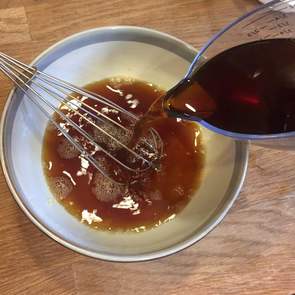Need something to cool down yourself but lazy to go out? Beat that late-summer heat with this homemade Japanese coffee jelly!!

Step 2: Add the hot coffee into the gelatin and mix thoroughly.
|
By Christy Wong, GVJCI Social Media and Community Outreach Intern I bet your mouth will drop when you open the weather app in your phone and saw the temperatures in the coming week… 93 Degrees!? Serious?! And even 100 degrees if you are up north..... Need something to cool down yourself but lazy to go out? Beat that late-summer heat with this homemade Japanese coffee jelly!! Coffee jelly, or Kohi Zeri in Japanese, is a light gelatin dessert that is served in many coffee shops in Japan, particularly during summer. It is very cold, refreshing, and not so sweet that makes it a great snack to help people cool down in this hot summer weather. Coffee and gelatin desserts are also very popular in Japan. Combining the two things together makes coffee jelly THE awesome dessert. Besides, it only takes a few easy steps to make it at home! So let’s get started! To make this Japanese coffee jelly, you will need: 3 tablespoons of water, ½ cup of sugar (The amount of sugar needed depends on how sweet you want your jelly to be!), 1 ½ tablespoons of unflavored gelatin, and 16oz of hot coffee. It is important that you use hot coffee so that you can combine all the ingredients together! Step 1: In a large bowl, pour water into the gelatin and let it soak for around 2 minutes.  Step 2: Add the hot coffee into the gelatin and mix thoroughly. At this point, you may see some clumps of gelatin not dissolving into the mixture. The mixture will also have a lot of bubbles on the surface due to constant stirring. But don’t worry! We will take care of this in the next step! Step 4: In this step, you will need a sieve, a thin pan/dish, and a soup ladle. Hold the sieve on top of the pan and carefully pour the coffee gelatin mixture through the sieve to get rid of the clumps of gelatin! Step 6: Cover the mixture with a plastic wrap and let it refrigerate for at least 4 hours to let the liquid set and become jelly. We know this is hard since the food is so attracting… But be patient everyone! Step 7: 4 hours later… the wait is over! It’s almost time to enjoy! Use a knife the cut the jelly into small squares. Step 8: Scoop out the jelly into the small bowl and you are ready to serve! And there you go! A refreshing and cooling Japanese coffee jelly! You can lightly whip up some heavy cream with sugar and pour the cream over the jelly. You can also pair up the jelly with sweetened condensed milk! You can even cut the jelly into very small rectangles to make “coffee boba” and add them into your cup of ice coffee! Enjoy! :D And stay cool in this hot weather everyone! ><
1 Comment
By Christy Wong, Social Media and Community Outreach Intern Mount Fuji, or Fujisan, is the tallest mountain in Japan and one of the most famous mountains in the world! Well, to be exact, it’s an active volcano. But don’t worry! It hasn’t erupted for a very long time. The last time it erupted was way back in 1707! The mountain is located on Honshu Island of Japan, approximately 60 miles from Tokyo. Many people, from professionals to amateurs, come all the way to Japan to challenge themselves to climb Mount Fuji. The official climbing season for Mount Fuji is from Early July to mid-September (which is happening RIGHT NOWWW!!) as the weather in the mountain is free of snow and not as severe as other times throughout the year. Given that the climbing season is soo short, Mount Fuji attracts thousands and thousands of professional and amateur climbers to challenge themselves and climb Mount Fuji. The climb maybe very long and tiring, but it is very rewarding when you see the sunrise from the summit of the mountain. Climbers become friends with one another easily as they support each other to reach their goals. In Japanese culture, Mount Fuji is associated with good luck too! So it is said that people will feel calm or even good fortune when they see the Mount Fuji! In an effort to celebrate this special 2 month-period time of the year, why don’t we make a cute Mount Fuji origami decoration!!! To make a Mount Fuji Origami, you will need: a piece of origami paper, some tape, and a few of your favorite watercolor pen! Step 1: Fold the paper in half to make a triangle shape twice. Step 2: Lift up the flap of one side of the triangle and press it down to form a trapezoid. Repeat the same step on the other side to form a sqaure. Step 3: Fold the corners of the opposite side of the square to the mid-point of the square. This creates 2 triangles within the square. Repeat the same step on the other side to form a rhombus. Step 4: Open up the triangle that you formed just now and press it down to make a rhombus-like shape. Repeat the same step on the 4 triangles that you made in the last step. Step 5: Open up the flap that is between the sides you are working on. Fold it into half to make a line on the middle of the paper. Fold two opposite side corners to the middle line, just like the picture shown below. Repeat this step on the other flap to create a rhombus. Step 6: Now we will work on the triangles that we folded just now in step 5! Fold the tips of the triangles down a little bit and fold the longest corner of the rhombus up to make a small triangle, just like the picture shown below. Repeat this step on the other side of the paper and the sides that are in between, which is totally 4 sides! Step 7: Get 4 small pieces of tape and roll it up so that they are like double-sided tapes. Set it aside for now since we will use them in the next step! Step 8: Secure the place of the small triangle using the double-sided tape you made just now! Repeat this step on the 4 small triangles you made in step 6. Step 9: Almost done! This is probably the easiest and the most fun part :P Decorate the red circled part with your favorite water color pen as it will be the summit of Mount Fuji! Step 10: This is the final step! Carefully open up the origami and press down the sides to make a square base. Hooray!! You have made yourself a Mount Fuji at home! :D It can be a great decoration on your work table or a cute pen/pencil holder! :P
Nicole Sato, GVJCI Program Coordinator May 5th is...? If you said Cinco De Mayo, okay, okay, you're not wrong, but we wanted Kodomo No Hi! as the answer. That's right. Every May 5th is Kodomo No Hi in Japan! What's Kodomo No Hi? It directly translates to: Kodomo (子供): Child(ren) No(の): 's Hi(日): Day. Yup, it's a day to celebrate children's health and happiness as well as thanking and celebrating mothers 🤰 Maybe you're like, "Wait. I thought today was Boy's Day???" Well, you're right and wrong. Boy's Day or Tango (that's with a short A not the long A like the smooth South American dance you all like 💃) No Sekku (丹後の節句) was officially changed into a Japanese holiday since 1948, when it became Children's Day. Boys are still celebrated though, as the means of celebrating (the koinobori, kabuto, etc) is still in tradition. Read on to find out! Feel like celebrating yet? Good! We'll talk about some things to get your Kodomo No Hi celebrations on the road! Koinobori 🎏
Kashiwa Mochi VS Chimaki
Do you celebrate Kodomo No Hi? How do you celebrate it? Did you learn something new? We hope so!
Couldn't come to our Day of Remembrance last month? No worries! We got the video for you, right here, so you can watch it on the go or at the comfort of your home. Thank you to John Powers for shooting the video as well as letting us share his work. Please note that Konrad Aderer's film Resistance at Tule Lake is not in the video due to copyrights. |
Archives
June 2024
Categories
All
|
|
COME VISIT US!
|
|
